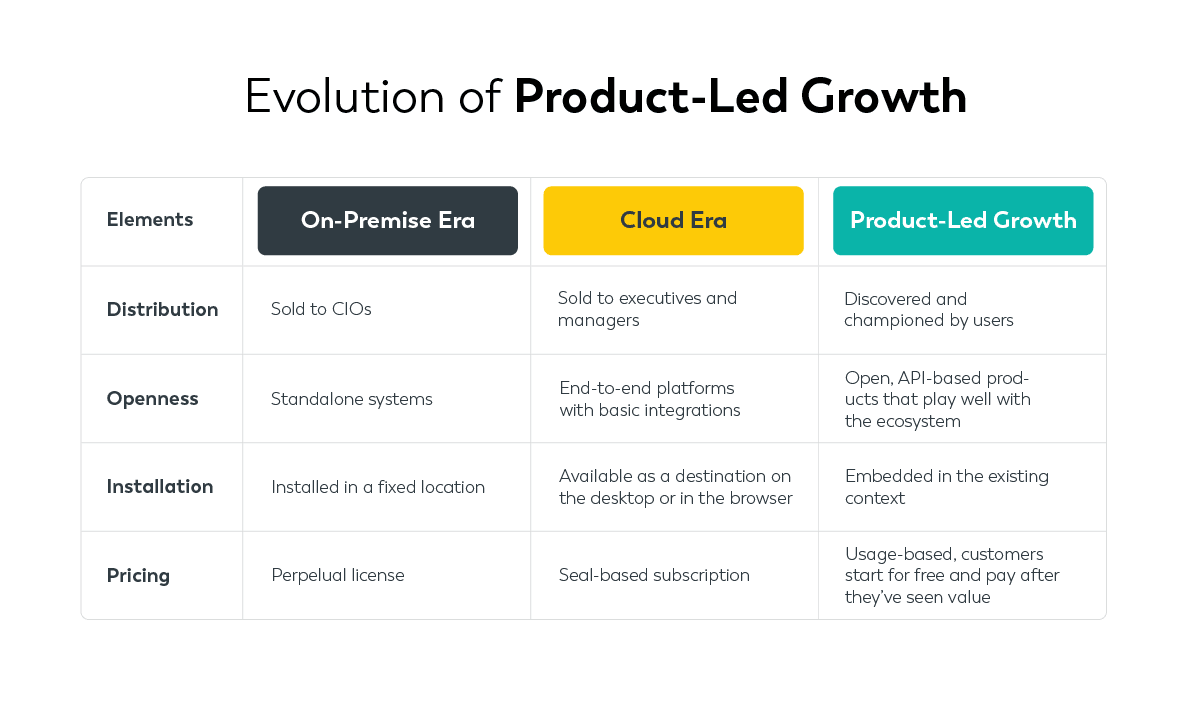Throughout the 20th century, the software industry was sales-driven. Department heads or board-level executives received pitches from sales execs and investigated product reviews before investing in standalone software packages that were individually installed onto end users’ devices. The users themselves often had little say in the process.
Today’s growth in SaaS has dovetailed with product-led growth principles. In the age of home working and device-agnostic interfaces, end users increasingly decide which platforms they use, and when/where they’re required. There may not even be any money changing hands—at least initially. This might sound strange, but the benefits of product-led growth are compelling, especially for SaaS firms. In this article, we outline some examples of product-led growth and why they’re beneficial, but we start with a few product-led growth principles.
Defining the issue
When software was sold in boxes with product activation codes, its success depended heavily on sales teams and marketing campaigns. By contrast, product-led growth relies on the strengths of the product itself. By creating a compelling piece of software, you let users (rather than buyers) discover and champion it for themselves. There’s no hard sell, no minimum contract period, and no upfront pricing. If the software is good enough, people will rate and review it, recommend it to friends and colleagues, and mention it in blogs like this one.
One of the best examples of the product-led growth philosophy in action is cloud storage—itself a thriving SaaS sector. Consumers can sign up in seconds for a limited amount of free storage on platforms like OneDrive or Dropbox. Within moments, they can have data safely stored on remote servers. Yet they could be customers for years, and paying ones at that. Once you reach your 2GB storage limit, what’s easier? Decanting everything back onto a C: drive and then seeking an alternative repository, or paying a few dollars a month for an extra 100GB of space?
Making it pay
While there are different methods of funding product-led growth SaaS platforms, including free trials, the freemium model is the most popular. Apps have normalized the principles of trying before you buy, with key functionalities off-limits unless paid for. This is one of the key benefits of product-led growth in the SaaS sector—customers can get under the hood and familiarize themselves with a platform for free. If the software is good enough, they’ll be happy to pay a premium for additional functionality. Deliver value first and recoup it later by upselling existing customers to a paid business model.
Speed is of the essence in this approach; the time to value should be as short as possible since “free” services are only free to the end user. It’s vital that software is straightforward to install and set up, intuitive to use and explain, and dependable enough to quickly become indispensable. In today’s mature SaaS market, that means developing a product that solves specific pain points. Customers should be so enamored with it that they recommend it—the ultimate sales tool—with one-click links and the ability to add guests/colleagues/intermediaries to their accounts.
Six degrees of separation
Through APIs and automation, product-led software platforms can often be connected, leveraging multiple functionalities. If you’re developing a new SaaS tool, think about the things it doesn’t offer and then try to connect it with platforms that do. Examples of product-led growth apps include Airtable, Atlassian, Zapier, and Zoom; in each case, integrations hugely increase the product’s appeal while making it less likely users will migrate away.
Frictionless use is a cornerstone of successful SaaS platforms like Slack and Netflix just as much as instant product value, with the added advantage that customers capable of onboarding themselves won’t require much tech support. If they do, this can be a paid upgrade to the freemium package they’re receiving.
This philosophy also requires every department in a SaaS business to be equally aligned. Instead of the board devising a product and instructing the tech team to develop it before the sales team promotes it, every department needs to prioritize the product at all times. Imagine different corporate departments as the individual colors in a rainbow, all following parallel paths toward the shared objective of a pot of gold. The corporate ethos required is summarized in Hotjar’s comparison of sales/marketing/product-led growth models.

Taking the next step
A product-led growth strategy might not be right for every business but it’s always worth considering. As a digital product agency, VeryCreatives has helped many SaaS brands make the progression from ideation to public launch, via minimum viable product and beta testing. If you’d like to discuss adopting a product-led growth strategy with your next SaaS product, get in touch with us.